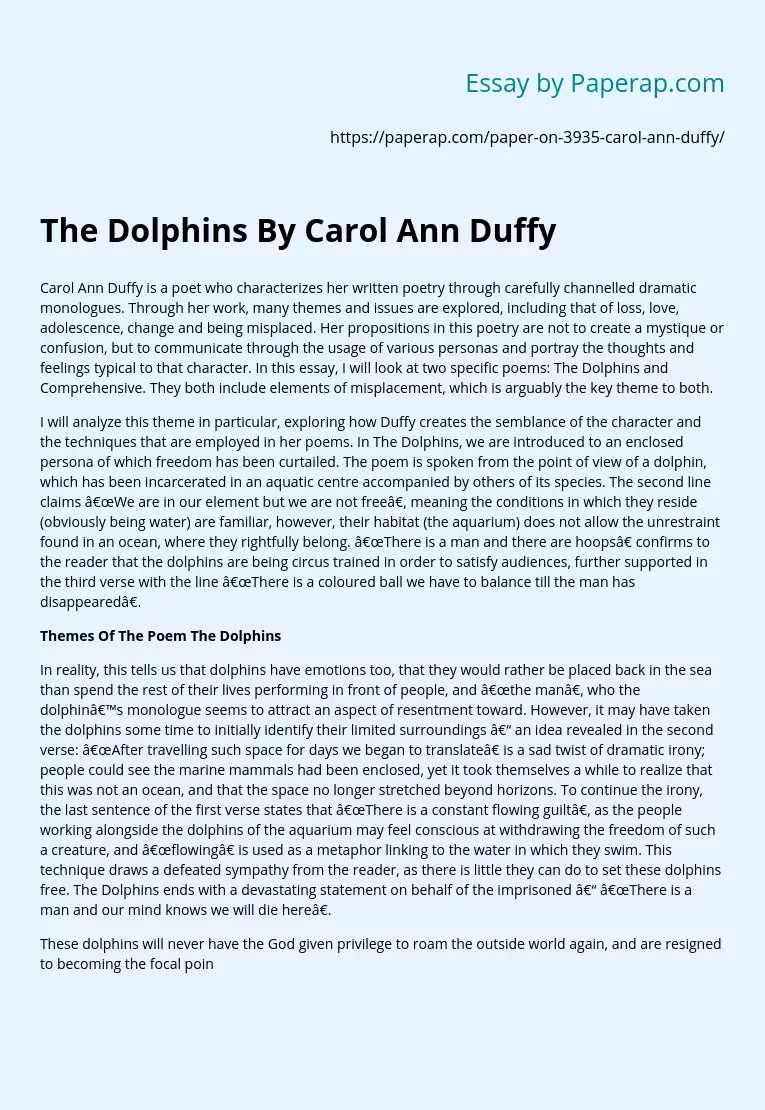The Dolphins By Carol Ann Duffy
Carol Ann Duffy is a poet who characterizes her written poetry through carefully channelled dramatic monologues. Through her work, many themes and issues are explored, including that of loss, love, adolescence, change and being misplaced. Her propositions in this poetry are not to create a mystique or confusion, but to communicate through the usage of various personas and portray the thoughts and feelings typical to that character. In this essay, I will look at two specific poems: The Dolphins and Comprehensive.
They both include elements of misplacement, which is arguably the key theme to both.
I will analyze this theme in particular, exploring how Duffy creates the semblance of the character and the techniques that are employed in her poems. In The Dolphins, we are introduced to an enclosed persona of which freedom has been curtailed. The poem is spoken from the point of view of a dolphin, which has been incarcerated in an aquatic centre accompanied by others of its species.
The second line claims “We are in our element but we are not free”, meaning the conditions in which they reside (obviously being water) are familiar, however, their habitat (the aquarium) does not allow the unrestraint found in an ocean, where they rightfully belong. “There is a man and there are hoops” confirms to the reader that the dolphins are being circus trained in order to satisfy audiences, further supported in the third verse with the line “There is a coloured ball we have to balance till the man has disappeared”.
Themes Of The Poem The Dolphins
In reality, this tells us that dolphins have emotions too, that they would rather be placed back in the sea than spend the rest of their lives performing in front of people, and “the man”, who the dolphin’s monologue seems to attract an aspect of resentment toward. However, it may have taken the dolphins some time to initially identify their limited surroundings – an idea revealed in the second verse: “After travelling such space for days we began to translate” is a sad twist of dramatic irony; people could see the marine mammals had been enclosed, yet it took themselves a while to realize that this was not an ocean, and that the space no longer stretched beyond horizons. To continue the irony, the last sentence of the first verse states that “There is a constant flowing guilt”, as the people working alongside the dolphins of the aquarium may feel conscious at withdrawing the freedom of such a creature, and “flowing” is used as a metaphor linking to the water in which they swim. This technique draws a defeated sympathy from the reader, as there is little they can do to set these dolphins free. The Dolphins ends with a devastating statement on behalf of the imprisoned – “There is a man and our mind knows we will die here”.
These dolphins will never have the God given privilege to roam the outside world again, and are resigned to becoming the focal point of public enjoyment. The poem, to a marginal degree, could also raise the argument of animal rights, depending on the interpretation of the person. The thought of staying in one place for such a long time for anyone would be highly constraining at the very least, and so to take a living being out of water for cheap entertainment provokes the question of whether such activity should even be legal. The poem explores the theme of misplacement through resigned emotion. The flexibility of freedom is valuable to the quality of life, and the dolphin’s persona seems to understand this very clearly.
The beginning of the third verse mourns “And now we are no longer blessed, for the world will not deepen to dream in”, and conveys its regret that they will no longer do as they please, that they are no longer “blessed”. The pool in which they stay will not expand its depths for the dolphins to cover new ground, and the line also metaphorically suggests that their dreams of independence are over in these shallow depths. The poem also displays the loss of hope through means of repetition. “There is” is a common phrase which appears in the poem on several occasions (“There is” a ‘constant flowing guilt’, ‘coloured ball’, ‘no hope’, amongst others) and this augments the effectiveness of the dolphin’s monologue, as a picture of their lives become clearer; as does the sorrowful tone.
The Dolphins By Carol Ann Duffy. (2019, Dec 05). Retrieved from https://paperap.com/paper-on-3935-carol-ann-duffy/

